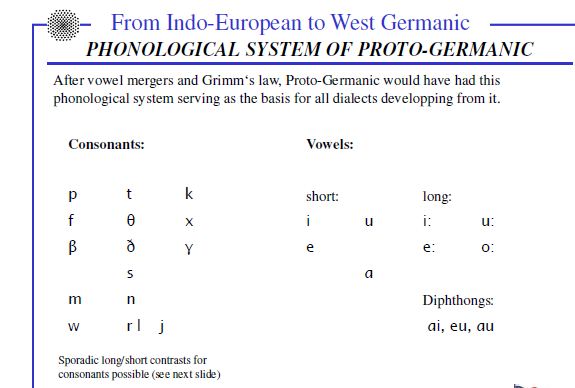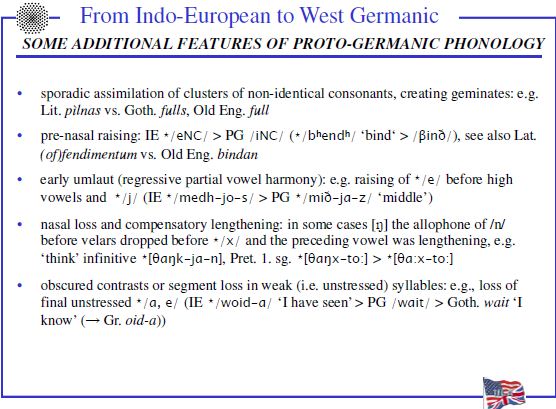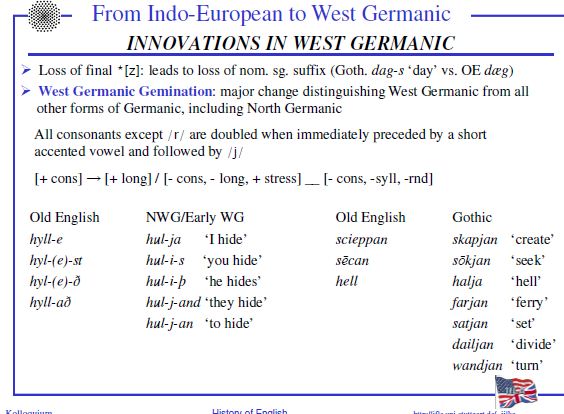
- •I. Теоретична фонетика
- •1. Розвиток фонологічної теорії у xXстолітті.
- •2. Система фонем і фонематичних опозицій сучасної англійської мови.
- •3. Інтонаційна система сучасної англійської мови. Структура інтонаційних одиниць. Функції інтонації
- •4. Сучасний стандарт англійської мови. Соціолінгвістичні фактори варіантності вимови.
- •5. Фоностилістика. Інтонаційні стилі мовлення.
- •Іі. Історія англійської мови
- •1. Характерні риси германських мов.
- •Фонетичні процеси в давньоанглійській та їх залишки в сучасній англійській мові.
- •3. Розвиток іменних граматичних категорій в англійській мові.
- •Історичний розвиток аналітичних форм дієслова в англійській мові.
- •5. Лінгвістичні наслідки скандинавського та норманського завоювань. Порівняння скандинавського та французького впливів. Розвиток національної літературної англійської мови.
- •Розвиток національної літературної англійської мови.
- •6. Фонологічні процеси у середньо- та ранньоновоанглійському періодах й формування системи фонем сучасної англійської мови.
- •7. Писемні пам'ятки давньо-, середньо- та новоанглійського періодів.
- •Ііі. Лексикологія
- •1. Етимологічний склад англійської мови. Типи запозичень.
- •2. Словотворення в англійській мові. Основні та другорядні типи словотворення.
- •3. Проблеми семасіології англійської мови. Типи значення слова. Полісемія.
- •4. Системна організація словникового складу англійської мови. Синонімія та антонімія.
- •5. Проблема визначення фразеологічних одиниць у сучасній англійській мові та їх класифікація.
- •IV. Теоретична граматика
- •1. Загальна характеристика граматичного складу сучасної англійської мови
- •2. Лексичні та граматичні аспекти англійського слова. Проблема визначення частин мови в сучасній лінгвістиці
- •3. Граматичні властивості та граматичні категорії іменника в сучасній англійській мові
- •4. Граматичні властивості та граматичні категорії дієлова в сучасній англійській мові
- •5. Сучасні підходи до вивчення речення та тексту: лінгвістика тексту, прагмалінгвістика, дискурсиний аналіз
- •V. Стилістика
- •1. Основні поняття стилістки англійської мови та інтерпретація художнього тексту
- •2. Стилістичне значення та його види. Силістична диференціація словникового складу сучасної англійської мови
- •3. Зображально-виражальні засоби та стилістичні прийоми сучасної англійської мови
- •4. Поняття функціонального стилю. Класифікація функціональних стилів в англійській мові.
- •5. Текст як категорія лінгвостилістики. Основні антропоцентри художнього тексту (образ автора, образ персонажа, образ читача)
Іі. Історія англійської мови
* OE = Old English; ME = Middle English; ModE = Modern English
1. Характерні риси германських мов.
Germanic languages, branch of the Indo-European language family. Scholars often divide the Germanic languages into three groups: West Germanic, including English, German, and Netherlandic (Dutch); North Germanic, including Danish,Swedish, Icelandic, Norwegian, and Faroese; and East Germanic, now extinct, comprising only Gothic and the languages of the Vandals, Burgundians, and a few other tribes.
Strong evidence for the unity of all the modern Germanic languages can be found in the phenomenon known as the first Germanic sound shift or consonant shift (also called Grimm's law), which set the Germanic subfamily apart from the other members of the Indo-European family. Consisting of a regular shifting of consonants in groups, the sound shift had already occurred by the time adequate records of the various Germanic languages began to be made in the 7th to 9th cent. According to Grimm's law, certain consonant sounds found in the ancient Indo-European languages (such as Latin, Greek, and Sanskrit) underwent a change in the Germanic tongue. For example, the sounds p, d, t, and k in the former became f, t, th, and h respectively in the latter, as in Latin pater, Englishfather; Latin dent, English tooth; and Latin cornu, English horn.
Before the 8th cent. a second shift of consonants took place in some of the West German dialects.
For instance, under certain circumstances, d became t, and t became ss or z, as in English bread, Dutch brood, but German Brot;
English foot, Dutch voet, but German Fuss; and English ten, Dutch tien, but German zehn. The dialects in which this second consonant shift took place were the High German dialects, so called because they were spoken in more mountainous areas. Standard modern German arose from these dialects. The West Germanic dialects not affected by the second shift were the Low German dialects of the lowlands, from which Dutch and English evolved.
Also peculiar to the Germanic languages is the recessive accent, whereby the stress usually falls on the first or root syllable of a word, especially a word of Germanic origin. Another distinctive characteristic shared by the Germanic languages is the umlaut, which is a type of vowel change in the root of a word. It is demonstrated in the pairs foot (singular), feet (plural) in English; fot (singular), fötter (plural) in Swedish; and Kampf (singular), Kämpfe (plural) in German.
All Germanic languages have strong and weak verbs; that is, they form the past tense and past participle either by changing the root vowel in the case of strong verbs (as in English lie, lay, lain or ring, rang, rung; German ringen, rang, gerungen ) or by adding as an ending -d (or -t ) or -ed in the case of weak verbs (as in English care, cared, cared or look, looked, looked; German fragen, fragte, gefragt ). Also typically Germanic is the formation of the genitive singular by the addition of -s or -es. Examples are English man, man's; Swedish hund, hunds; German Lehrer, Lehrers or Mann, Mannes. Moreover, the comparison of adjectives in the Germanic languages follows a parallel pattern, as in English: rich, richer, richest; German reich, reicher, reichst; and Swedish rik, rikare, rikast.Lastly, vocabulary furnished evidence of a common origin for the Germanic languages in that a number of the basic words in these languages are similar in form; however, while word similarity may indicate the same original source for a group of languages, it can also be a sign of borrowing.
Form-building means. Like other old IE languages both PG and the OG languages had a synthetic grammatical structure, which means that the relationships between the parts of the sentence were shown by the forms of the words rather than by their position or by auxiliary words. In the early periods of history the grammatical forms were built in the synthetic way: by means of inflections, sound interchanges and suppletion. The principal means of form-building were inflections. The inflections found in OG written records correspond to the inflections used in non-Germanic languages, having descended from the same original IE prototypes. The wide use of sound interchanges has always been a characteristic feature of the Germanic group. In various forms of the word and in words derived from one and the same root, the root-morpheme appeared as a set of variants. The consonants were relatively stable, the vowels were variable.
Simplification of word structure . Originally, in Early PG the word consisted of three main component parts: the root, the stem-suffix and the grammatical ending. The stem-suffix was a means of word derivation, the ending – a marker of the grammatical form. In Late PG the old stem-suffixes lost their derivational force and merged with other components of the word, usually with the endings. The word was simplified: the three-morpheme structure was transformed into a two-morpheme structure. The simplification of the word structure and the loss of stem-suffixes as distinct components were caused by the heavy Germanic word stress fixed on the root. Most nouns and adjectives in PG, and also many verbs, had stem-forming suffixes; according to stem-suffixes they fell into groups, or classes: a-stems, i-stems, o-stems. This grouping accounts for the formation of different declensions in nouns and adjectives, and for some differences in the conjugation of verbs.
Vocabulary. Until recently it was believed that the Germanic languages had a large proportion of words, which have no parallels in other groups of the IE family. Recent research, however, has revealed numerous non-Germanic parallels for words formerly regarded as specifically Germanic. It appears that Germanic has inherited and preserved many IE features in lexis a well as at other levels. The most ancient etymological layer in the Germanic vocabulary is made up of words (or, more precisely, roots) shared by IE languages. They refer to a number of semantic spheres: natural phenomena, plants and animals, terms of kinship and so on. Words which occur in Germanic alone and have no parallels outside the group constitute the specific features of the Germanic languages; they appeared in PG or in later history of separate languages from purely Germanic roots. Semantically, they also belong to basic spheres of life: nature, sea, home life. Also, there were some borrowing words from Latin and Celtic languages.
Characteristics:
1. All the G.L. of past & present have common linguistic features, some of these features are shared by other groups in the IE family, others are specifically Germanic.
2. The Germanic group of lang. acquired their specific distinctive features after the separation of the ancient Germanic tribes from other IE tribes and prior to their expansion and disintegration that is during the period of the Proto Germanic language ( unattested). The aim is to provide the general idea of what the PGLang was like, to point out its linguistic ftatures. Theese PGfeatures, inherited by the descendant l-ges, represent the common features of the Germanic group.
3. Other common features developed later in the course of individual history of separate Germanic l-ges as a result of similar tendencies from PG causes. On the other hand many Germanic features have been disguised, transformed and even lost in later history.
Germanic languages possess several unique features !!!, such as the following:
1. A large class of verbs that use a dental suffix (/d/ or /t/) instead of vowel alternation (Indo-European ablaut) to indicate past tense; these are called the Germanic weak verbs; the remaining verbs with vowel ablaut are the Germanic strong verbs
2. The shifting of stress accent onto the root of the stem and later to the first syllable of the word
3. Another characteristic of Germanic languages is the verb second or V2 word order. This feature is shared by all modern Germanic languages except modern English
4. Strict differentiation of short and long vowels
5. Tendency for assimilation and reduction
6. A great number of fricatives, small number of plosives
7. No palatal consonants at all.
2. Спільногерманська та класична давньоанглійська системи фонем у порівнянні (короткі та довгі монофтонги, нові голосні у давньоанглійській мові, розщеплення велярних k/і/g/). Фонологічні процеси у давньоанглійській мові та їх залишки в сучасній англійській мові. Розвиток голосних в ненаголошених складах в історії англійської мови.



